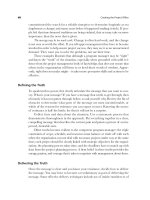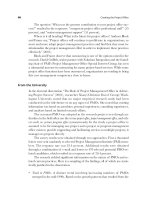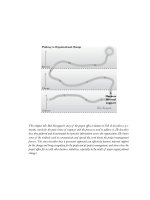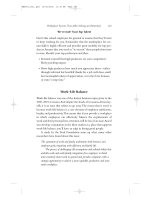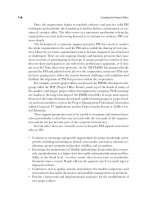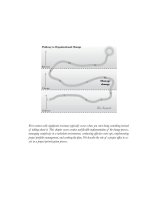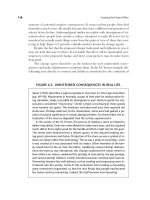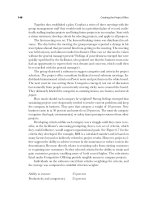Creating the project office 18
Bạn đang xem bản rút gọn của tài liệu. Xem và tải ngay bản đầy đủ của tài liệu tại đây (80.62 KB, 10 trang )
Together they established a plan. Conduct a series of three meetings with the
group management staff that would result in a prioritized plan of record, realis-
tically staffing in-plan projects and listing future projects in an out-plan. Start with
a vision statement, develop criteria for selecting projects, and apply to all projects.
The first meeting was set. The forward-looking vision was distributed in ad-
vance. The day before the meeting, the group manager reported a change in his
travel plans abroad that prevented him from getting to the meeting. The meeting
was held anyway and almost resulted in disaster. How can we discuss the vision
without the general manager present? Feelings of powerlessness emerged but were
quickly squelched by the facilitator, who pointed out that the business team now
had an opportunity to express their own dreams and concerns, which could then
be reconciled with the general manager’s.
The group chartered a subteam to suggest categories and criteria for project
selection. The project office consultant facilitated several subteam meetings. In-
dividuals brainstormed criteria on Post-it notes and put them on the white board.
The next exercise was sorting them. Categories emerged, not out of discussion
but naturally from people concurrently moving sticky notes around the board.
They ultimately labeled the categories as sustaining business, new business, and must-do
projects.
How much should each category be weighted? Strong feelings emerged that
sustaining projects were desperately needed to resolve current problems and keep
the company in business. They gave that category a weight of 50 percent. New
business came in at 30 percent and must-do at 20 percent. The must-do category
recognizes that legal, environmental, or safety issues preempt resources from other
projects.
Developing criteria within each category was a struggle until they came to re-
alize, at the facilitator’s unceasing prompting, that a core set of criteria, which
they could influence, would support organizational goals. See Figure 6.7 for the
criteria they developed. For example, ROI is a calculated number and is based on
many factors beyond or indirectly related to project results. However, projects ei-
ther support the ability to achieve revenue in the numerator or reduce costs in the
denominator. Revenue directly relates to retaining sales from existing customers
or to gaining new customers. So they selected criteria for the ability to retain and
gain customers; projects enabling more of both scored higher. The subcriteria
listed under Competitive Offering provide tangible means to compare projects.
Individuals on the subteam voted their relative weightings for criteria, and
the average was computed to establish criterion weights:
Ability to execute 35 percent
Productivity and competency 25 percent
148 Creating the Project Office
Strategic fit 20 percent
Competitive offering 20 percent
Despite initial doubts that their input would be valued, team members de-
signed a plan for balancing the general manager’s forward-looking vision with re-
alities of executing current projects. Upon reconvening the management team
with the subteam, the facilitator reopened discussion about vision and direction,
since the general manager was now present. A welcome surprise (and an Ah ha
entered into the facilitator’s knowledge base) was that starting with a sense of di-
rection and defining categories and criteria and weighting factors offered a con-
vergence path. They would and could do it all (but not do all projects). The lesson
learned was that the iterative process of forming goals and defining criteria to as-
sess whether they are being met are inextricably intermixed—each supports the
other and both are required.
The general manager and his staff embraced recommended criteria that
came out of intense collaboration within the subteam. Instead of pushing his own
agenda, the manager was pulled by the thoroughness and integrity that emerged
from this work. Everyone agreed to move on to the next step—capture a project
list and apply the criteria.
Using electronic media, the project managers used the criteria from the
spreadsheet in Figure 6.7 to self-score their projects against the criteria. The
project office consolidated all projects into a master list. Scores were presented
and discussed at the next meeting to ensure agreement.
“How many people are available to do projects?” The consolidated worksheet
indicated 224 people were required to do all fifty-one projects that needed to be
completed over the following year (Figure 6.8). Silence. Finally the IT manager
led the group to guesstimate that seventy-five people were available to work on
projects that year.
At this point it is not important for the numbers to be totally accurate. The
broad-brush picture shows too many projects under way or contemplated by too
few people. It also shows underinvestment in sustaining projects and overinvest-
ment in new business projects, compared to the desired mix. The first task is to
get assignments in line with organizational goals and capacity. Fine-tuning hap-
pens later based on actual project planning after adjustments are made—projects
funded, postponed, or cancelled. Careful review becomes especially important for
projects around the cut line.
Note that headcount resources are the constraining factor in this example.
Other cases may use total dollars or other units pertinent to the business.
The cut line in each category is a product of resources times desired mix. For
example, 75 people × 50 percent = 37.5 head count (HC) that can be applied to
Contact 149
sustaining business projects. Apply the same arithmetic to the percentage desired
for each category to determine cut lines. Figure 6.9 shows these calculations.
The true test came when the group assessed the prioritized project list. One
business manager felt threatened when a large project within his department fell
below the cut line. In the past, this particular manager would have found a way to
implement it on his own. He argued the project was a good one and promised high
return on investment. This pattern of behavior had created some of the unit’s cur-
rent problems—all projects under consideration were good ones, the resources just
were not sufficient to do them all. The team usually operated virtually across in-
ternational boundaries, allowing autonomous action, free of challenge. But this
was a mandatory in-person meeting. The project office facilitator drove the process
and kept the managers on track to achieve a plan they would all support. One man-
ager openly questioned if the other would stick to the plan. This was not a com-
150 Creating the Project Office
FIGURE 6.7. WORKSHEET OF SAMPLE CRITERIA.
Ability to Execute Productivity
Sustaining
business
50%
Time to
complete
Resources
required
Right
resources
available
Geographic
dispersion
Full time
versus
part time
Workload
reduction,
productivity
improvement
Time
and
breadth
Strategic Fit Ability to Execute
New
business
30%
Market
attractiveness
Supports
business
strategy for
business
Importance
as a core
competency
(strategic
leverage)
Worldwide or
multinational
benefit
Time
to
complete
Resources
required
Ability to Execute
Must-Do
20%
Time to
complete
Resources
required
Right
resources
available
Geographic
dispersion
fortable moment. She persisted in questioning, and he hesitated to commit. A safe
environment allowed this confrontation to happen without doing any damage.
What happened next was creativity forged out of desperation. Instead of
doing the whole large project, the manager agreed to start with a small subset
whose return potential was high and whose profile more closely aligned with the
criteria. Besides, the resources required were overseas and could not be deployed
on projects above the cut line because of either skill set or geographic location.
The group agreed to take an option on this project—start with a small investment
and reevaluate later if further investment is warranted. Another approach would
have been to invest seed money—usually a small amount—in an idea or venture,
and fund the project fully later if a harvest developed.
Through open, face-to-face discussions, led by an outside facilitator from the proj-
ect office, the entire group came to agreement on how best to achieve division-wide
Contact 151
Strategic Fit Competitive Offering
Supports
business
strategy for
organization
Critical to
maintain
business
Importance
as core
competency
Worldwide
or multinational
benefit
Builds
competitive
advantage
(attracts new
customers)
Customer
loyalty
(keeps existing
customers)
Ability to Execute Competitive Offering
Right
resources
available
Geographic
dispersion
Builds
competitive
advantage
(attracts new
customers)
Market
acceptance
Customer
loyalty
(keeps
existing
customers)
goals. The leader’s support for the integrity of the process created an environment
that allowed this team to succeed.
The general manager demonstrated further integrity when he asked the team
to help him identify the top three projects. Since he had a meeting with his man-
ager the next day and needed to report how the organization would meet its goals,
the general manager solicited input from the team. Now they knew he seriously
wanted their involvement and would act on it. This was not a “going through the
motions” exercise; the business would be run according to the results of the
process that they were part of creating and implementing.
In this example, the project office facilitator came into a chaotic situation and
invoked portfolio and behavioral processes to manage the complexity. Greg went
back to his “real job,” happy that experts from the PO were available when he
needed them.
Portfolio Tools
A typical way to prioritize items is to brainstorm and then have people vote their
top three favorites. Type the items into a computer, arrange them in categories,
project them onto a white board, and mark votes on the board. Record results
with a digital camera. The most popular items become quite evident.
152 Creating the Project Office
FIGURE 6.8. SUMMARY OF PROJECTS.
Category Head Count Actual Versus
Target
22 Sustaining
projects
80 Person-months
36% versus
50%
23 New
business projects
120 Person-months
54% versus
30%
6 Must-do
projects
22 Person-months
10% versus
20%
